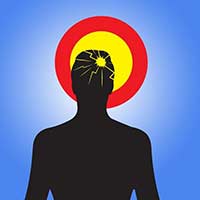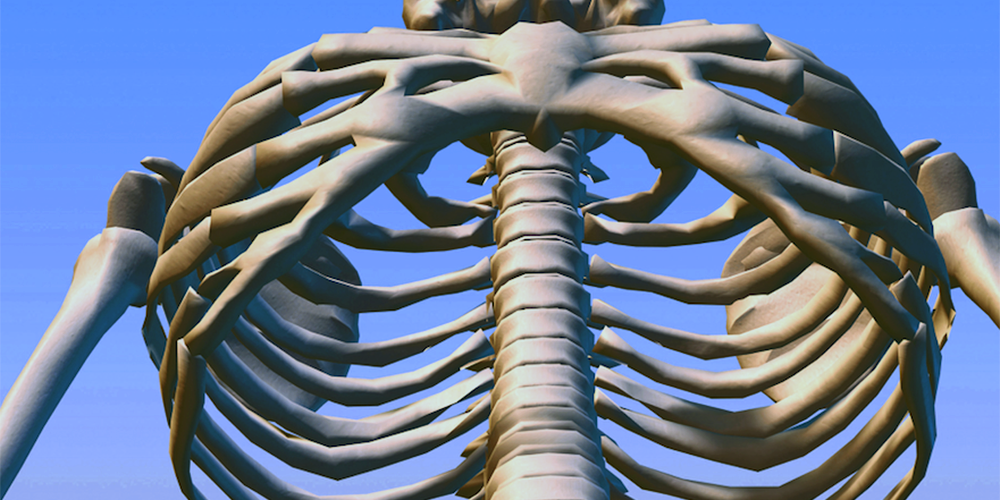According to the statistics from the Centers for Disease Control and Prevention of the United States, more than 795,000 people in the United States suffer from stroke and about 610,000 of these are first or new strokes. Stroke costs the United States an estimated $34 billion each year. This total includes the cost of health care services, medicines to treat stroke, and missed days of work1.
The majority of chiropractors can help stroke victims by addressing the subluxations in the spine and adjust it accordingly to allow optimal functioning of the neuromusculoskeletal system. However, “Is subluxation only limited to the spine?” The definition of subluxation by Stephenson in 1946 was, “A subluxation is the condition of a vertebra that has lost its proper juxtaposition 
with the one above or below or both; to an extent less than a luxation; which impinges nerve interferes with the transmission of mental impulses.2 ” In my point of view, it can also happen in the rib cage.
The rib cage is a very strong structure to protect our vital organs (heart, lungs, blood vessels, and nerves) but also flexible to allow movement during respiration. Furthermore, it connects our core muscles where the extremity movements are initiated from. Many times chiropractors are too focused on the spine, and they ignore the fact that those rib subluxations of the rib joints can also result in accumulation of toxins in the body, repetitive traumas and negative thoughts which ultimately lead to “Dis-ease”.
When a rib is subluxated, it causes inflammation in the joint capsule, which leads to pain and chemical irritation to the paravertebral ganglion, which is situated next to the costovertebral articulation and affects the sympathetic nervous system. The body is under a “Flight or Flight” response and secretes excessive sympathetic hormones such as norepinephrine, epinephrine, and cortisol through the adrenal medulla and cortex. Research has shown that there is an inverse relationship between the secretion of cortisol and melatonin which affect circadian rhythms3, and how sleep-wake disturbances affect short and long-term stroke recovery by impairing neuroplasticity and reduction of aphasia4.
Furthermore, rib subluxations can impair the musculoskeletal system. One of the most common characteristics of stroke victims is that they have spastic and hypertonic muscles on one side of their body. The abnormal muscle tone with the addition of inability to coordinate their muscles alter the biomechanics of their normal movements, and the rib joints are vulnerable to microtrauma and therefore subluxate. Pain and muscle guarding reflex result in a forward posture creating a hyperkyphotic curvature that predisposes the patient to degeneration of the rib joints and the spine, loss of upper extremity range of motion, chronic stress and deconditioning syndrome.
Rehabilitation from rib subluxation for stroke victims needs special attention from chiropractors because of its extensive damage to the brain and the body, but it should be indifferent to the chiropractic recovery model which is pain management, maintenance and prevention.
“Stroke victims can be suffering from multiple joint dysfunctions related to stroke. The therapy for these patients focuses on the non-stroke affected side. Medicare will not approve therapy for the stroke-affected side, and most insurance companies follow suit. So the therapy that is used is focused on strengthening the good side and training in becoming one-handed or one-legged in their activities of daily living.5”
Chiropractors should apply a full assessment bilaterally; start with visualizing posture and breathing patterns, then static palpation for chronic edema and point tenderness at sternochondral, costochondral junction, and costovertebral joints. Moreover, look for taut and tender fibers at serratus anterior, pectoralis major/minor, rotator cuffs, and scalenes which originate or insert on the ribs. After that, motion palpate global and segmental rib movement by placing chiropractic index and middle finger at the intercostal space in the anterior, lateral, and posterior area during respiration6. It is highly recommended to measure their breathing capacity by spirometer, cardiopulmonary function during exercise, and autonomic nervous system by a heart rate variability device in order to monitor the progress throughout the course of treatment.
Manual chiropractic adjustments are not recommended in the beginning of care due to the spastic and hypertonic muscle tone for stroke victims which can create shock and discomfort. Therefore osseous adjusting with drop table, spring-loaded instrument, speeder board, or active-release technique should be utilized to correct the subluxations for pain management. In the maintenance stage chiropractors can apply non-osseous adjustment such as Network technique, reducing the tension throughout the body and rib cage to enhance optimal connection in the neuromusculoskeletal system. Moreover, inspiratory muscle training, core strengthening, and proper exercise biomechanics should be introduced in order to provide better stabilization on rib cage and cardiovascular autonomic control7. Last but not least, it is very important for chiropractic practitioners to help stroke victims to prevent injuries, especially falls, by a full evaluation of their coordination and what they do in their daily life.
“Love me for who I am today.8” This is the inner voice from most stroke victims. As chiropractic practitioners, we should never only focus on correcting biomechanical misalignments in the body, but also treat the chemical and emotional components of subluxation for everyone, including stroke victims. I have faith that one day we will be the first person stroke victims would go to in the future.
Thank you for everything you do for me, my mom.
This article first appeared in the February 2020 issue of Lifelines, the Life West student magazine.
Resources
- Benjamin EJ, Blaha MJ, Chiuve SE, et al. on behalf of the American Heart Association Statistics Committee and Stroke Statistics Subcommittee. Heart disease and stroke statistics—2017 update: a report from the American Heart Association. Circulation. 2017;135:e229-e445.
- Stephenson RW. Chiropractic textbook. Davenport, IA: The Palmer School of Chiropractic; 1946.
- Adamczak-Ratajczak A, Kupsz J, Owecki M, Zielonka D, Sowinska A, Checinska-Maciejewska Z, Krauss H, Michalak S, Gibas-Dorna M. Circadian rhythms of melatonin and cortisol in manifest Huntington’s disease and in acute cortical ischemic stroke. J Physiol Pharmacol. 2017 Aug;68(4):539-546. PMID: 29151070.
- Hermann DM, Bassetti CL. Role of sleep-disordered breathing and sleep-wake disturbances for stroke and stroke recovery. Neurology. 2016 Sep 27;87(13):1407-16. doi: 10.1212/WNL.0000000000003037. Epub 2016 Aug 3. PMID: 27488603; PMCID: PMC5047039.
- Ruch WJ. Advanced adjusting techniques: chiropractic care for physically compromised patients. Hayward, CA: Life West Press; 2018.
- Flynn TW. The thoracic spine and rib cage: musculoskeletal evaluation and treatment. Boston: Butterworth-Heinemann; 1996.
- De Abreu RM, Rehder-Santos P, Minatel V, Dos Santos GL, Catai AM. Effects of inspiratory muscle training on cardiovascular autonomic control: A systematic review. Auton Neurosci. 2017 Dec;208:29-35. doi: 10.1016/j.autneu.2017.09.002. Epub 2017 Sep 7. PMID: 28916152.
- Taylor JB. My stroke of insight: a brain scientist. New York: Viking; 2006.
- Doidge N. The brain that changes itself: stories of personal triumph from the frontiers of brain science. Strawberry Hills, NSW: ReadHowYouWant; 2017.
- Gatterman MI. Foundations of Chiropractic website: Subluxation. London: Elsevier Health Sciences; 2005.



Yui Fu Lam
This article was written by YUI FU JERRY LAM- LIFEWEST STUDENT (FALL 2017)
Kopi Joni
good article
Cedric Bonjuand
Very interresting, thanks.